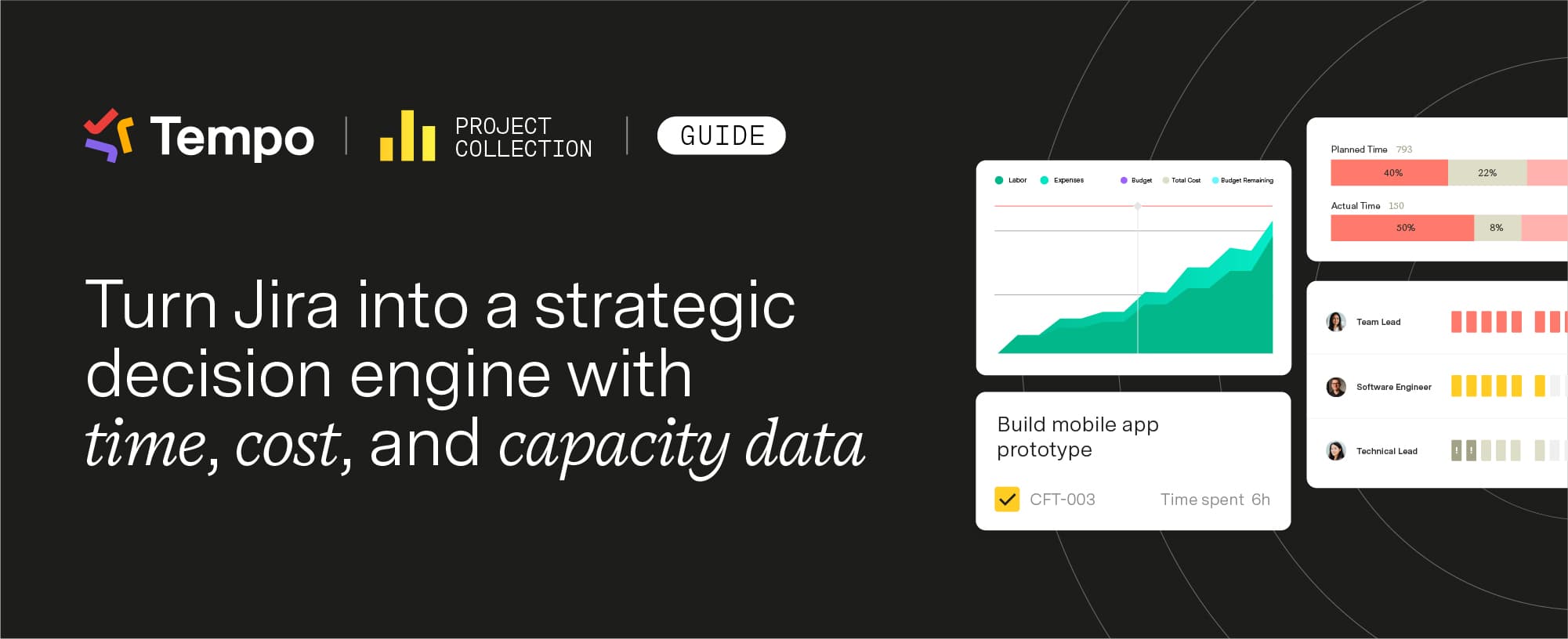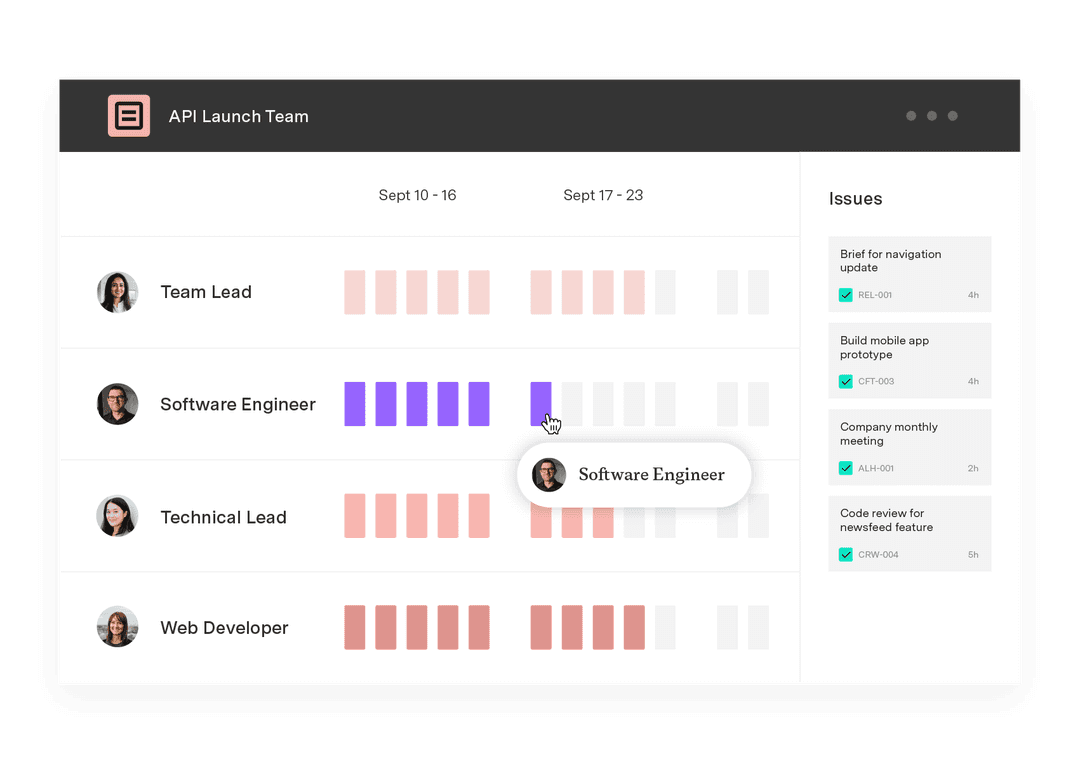Turn Jira into a strategic decision engine with time, cost, and capacity data
Tempo Team

Jira is packed with rich information. Are you using it as a strategic command center?
Every status update, every ticket, every hour logged, and every assignment in Jira contains a tidbit of strategic intelligence. What if you could tap into that wealth of data to gain actionable insights and transform the way you make decisions?
One of the biggest blockers? Well, it’s the simple fact that operational data in Jira is often messy and incomplete. Different teams track work in different ways. Meanwhile, strategic decisions happen somewhere else entirely – in spreadsheets, slide decks, or conference rooms far from where work happens.
Something powerful happens if you can capture time, cost, and resource data consistently, and then connect it to business outcomes: You can answer strategic questions instantly.
This guide is about transforming Jira from a project tracker into a decision engine.
Driving faster, smarter decisions from project data
There’s no shortage of data in Jira. You probably collect mountains of it every day: Hours logged, budget updates, resource assignments; task status updates. But is it good enough to inform strategic planning?
In many companies, information is isolated. Project data is in one system, financial data in another, and resource management elsewhere. Teams track work inconsistently, or don’t track it at all. By the time reports get compiled manually, the information is already outdated.
Without real-time visibility, you end up with bottlenecks, budget overruns, and misaligned priorities. There’s no clear way to tell whether projects deliver ROI or track with high-level organizational goals.
Fundamental questions go unanswered: Which projects generate the most value relative to their cost? Are we deploying the right people to the highest-priority work? Where should we invest resources based on what’s actually happening right now?
The strategic triad: Time, cost, and capacity data
In the professional services field, on-time project delivery is 73.4% according to a 2025 benchmark report by SPI Research. When delivery dates are missed, that’s a sign of a disconnect between how projects are scoped out and delivered.
The foundation of project intelligence is built on time, cost, and team allocation. These assets are finite; every strategic decision involves distributing constrained resources across competing priorities.
Turn Jira into a decision engine
Read the blogTracking time consistently helps you understand project velocity and forecasting. Connecting time and cost data shows the real financial impact of work. And when you add capacity data, you can plan without risk of bottlenecks and burnout.

Time tracking as the foundation
Time is the most fundamental measure of where effort goes. It’s also critical to project success. Some organizations treat time tracking as a compliance requirement, but it’s far more valuable as a driver of operational excellence and project governance.
"Time is the scarcest resource and unless it is managed nothing else can be managed." - Peter Drucker
Accurate time data reveals when tasks take longer than estimated, signaling scope creep or highlighting patterns in how different teams or individuals approach similar tasks.
Time tracking connects directly to budgets and resource planning. When you know how long tasks actually take, you can budget for similar work in the future.
The key is moving from inconsistent tracking to reliable, habitual data capture. This doesn't mean micromanaging every minute. It means creating systems where logging time is a natural part of workflows, where automations and integrations pre-populate entries, and where time can be captured with minimal friction – directly in Jira.
"We saw 20% billable utilization growth and shortened delivery times by 59% on average almost instantly." - Dzmitry Hryb, Strategic Marketing Manager at Deviniti

Cost management and financial visibility
Traditional project budgeting still happens in spreadsheets. Budgets get set, then months later you find out if they were accurate. This treats financial management as backward-looking accounting rather than forward-looking strategy.
With time and cost data connected, you have accurate project economics. When hours get logged in Jira, and you know the hourly rates or salary costs, you can see true project costs in real-time.
That visibility helps avoid budget surprises and allows you to course correct early, while there’s still time to influence outcomes.
Cost data is especially powerful for prioritization and trade-off decisions. Every organization has more potential projects than resources to complete them. With the right cost data, you can compare expected value vs actual investment – instead of choosing priorities based on intuition or politics.
Case study: BAE Systems
BAE Systems provides some of the world's most advanced technology-led defense, aerospace, and security solutions.
Their project managers relied on status reports from team leads, rather than using Jira data directly. It was a challenge to conduct monthly finance status reviews or to pinpoint cost overruns across multiple engineering teams. That's when they found Financial Manager.
"I saw the potential of Financial Manager, so I tried it on a complex major program. I liked the way it reused existing issue backlogs to create historical earned value and clearly shows progress vs budget." - Damian Le Gresley, Head of Engineering Improvement at BAE Systems
Financial Manager saved project managers time preparing for monthly project reviews as they no longer have to generate earned value graphs manually. It has also made the cost/schedule trend more visible to both the development and project teams, empowering them to take early corrective action.
The team was able to enter their resourcing information to get a future actual projection. Then, Financial Manager provided a forecast of the projected completion date and costs for the program by extrapolating the earned value metric.

Team allocation and capacity planning
Capacity data completes the strategic picture by showing whether the right people are working on the most important projects at the right time.
Many organizations lack this visibility, but it’s critical to business agility. When priorities shift, capacity data shows who has availability and the right skillset to pull into a new project. It shows whether you can accelerate an initiative or start hiring first.
Further, visibility into capacity and resource allocation is what you need to spot project bottlenecks and avoid burnout.

Jira as your strategic hub
Connecting time, cost, and capacity data in Jira creates a single source of truth for project decisions. Instead of bouncing between timesheets, financial systems, and spreadsheets, you can get insights in the same place where your teams already work.
Tempo's suite of tools makes this integration practical:
Timesheets captures time data where teams already work in Jira.
Financial Manager connects time to costs with configurable rate structures.
Capacity Planner shows resource allocation across projects and teams.
Turn Jira into a strategic hub powered by real data
Read the blogEach tool is modular and adapts to different teams’ ways of working, which helps get closer to the consistent, cross-departmental data your company needs to make the smartest possible decisions.
"From creating and assigning tasks to tracking progress and managing resources, every aspect of project planning is made efficient and effortless." - Gennadii Danilov, Jira user
These tools are the building blocks for proactive project management – real-time dashboards, trend analysis from live data, predictive insights, bottleneck risks, and planned vs actual reports.
For those using business intelligence tools, Jira becomes a reliable data source – enabling executive dashboards that reflect the same reality teams see in their daily work.
With complete project data flowing through Jira, scenario planning goes from theoretical exercises to concrete analysis. Forecasting changes fundamentally when it accounts for time, cost, and resources together.
Start capturing reliable time, cost, and resource data
Read the blogProject data creates strategic clarity, and it shortens decision cycles. Which combination of projects can be expected to maximize business value? Which projects consistently deliver high value efficiently and which consume disproportionate resources? Check the dashboard.
It’s time to gain better visibility into what's happening, clarity about where you’re headed, and confidence that your strategic decisions are based on solid information. The data is already there in Jira. The question is whether you’ll unlock its potential.
“With the Project Collection, we can give project leaders the clarity they’ve been craving. They now have a structured view of project progress that enables better planning, faster delivery, and more confident decisions. - Jaclyn Mazzarella, Global Head of Alliance at Valiantys
Take the next steps toward turning Jira into a strategic decision engine with Tempo's Project Collection.
Track, plan, and optimize time and capacity directly in Jira.
See the Project Collection

